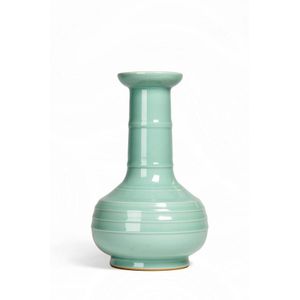Qing Crackle Glaze Stem Vase, 12cm
You must be a subscriber, and be logged in to view price and dealer details.
Subscribe Now to view actual auction price for this item
When you subscribe, you have the option of setting the currency in which to display prices to $Au, $US, $NZ or Stg.
- Qing Dynasty - The Qing Dynasty was the last imperial dynasty of China, ruling from 1644 to 1912. It was established by the Manchu people, who originated from the northeastern region of China. The Qing Dynasty was preceded by the Ming Dynasty and followed by the Republic of China.
- Crackles / Cracquelure - In ceramics, crackles may be introduced intentionally during the firing process, as was often the case with Oriental ceramics, and are known as artificial crackles. Natural crackles occur with age, and if the glaze is transparent, may be difficult to detect. Natural crackles may not cover the whole surface of the object and may be uneven in size.
- Crackling and Crackle as a Decorative Technique - Crackle, also known as crackling, is a decorative technique that has been used in China for centuries. It is believed to have originated during the Song Dynasty (960?1279 AD) and was primarily used in the production of ceramics, lacquerware, and furniture. The crackling effect was achieved by applying a glaze or lacquer that was formulated to crack during firing, creating a crackled pattern on the surface of the item.
During the Ming Dynasty (1368?1644 AD), crackle became a highly sought-after decorative technique, and it was used to create intricate and beautiful designs on ceramics and lacquer ware.
In Western decorative arts, crackle / crackling came into use during the Art Nouveau movement in the late 19th and early 20th century. The crackling effect was used to create a sense of movement and fluidity in the design of Art Nouveau pieces.
It was also used in the 1920s and 1930s during the Art Deco movement.
This item has been included into following indexes:
Visually similar items

Miniature Longquan celadon arrow vase, burnt iron red foot. Firing defect to shoulder. Height 15 cm

A Chinese Qianlong-style. Gu vase. Grey/green glaze with various lugs, flared neck. Repair to rim. Blue Qianlong mark to base. Height 25.5 cm

A Chinese green-and-crackle glaze long-neck vase, Late Qing dynasty or Republic period 37.5 cm high. Provenance: Private collection NSW

A fine celadon-glazed porcelain Studio vase, early 20th century, impressed seal of Miyanaga Tozan 1 (1868-1941), the wonderful glaze and the shape are inspired by the Chinese ceramics of the Northern song period, 28 cm high, inscribed original fitted box
